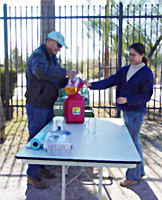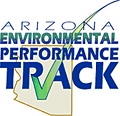Pacific Southwest, Region 9
Serving: Arizona, California, Hawaii, Nevada, Pacific Islands, Tribal Nations
 Activity in Arizona
Activity in Arizona
On this page:
- Gila River: From Frybread to Fuel Tank
- City of Scottsdale: On the Right Track
- Deer Valley School District: Using Biodiesel Since 1999
Gila River: From Frybread to the Fuel Tank

From Frybread to the Fuel Tank
The Gila River Indian Community in Maricopa County, AZ worked on a post consumer recycling demonstration project promoting the conversion of waste cooking oil to biodiesel from local casinos and restaurants for use on the reservation.
The project was well received by the community, local utilities, and Tribal agencies. The Tribe hopes to continue using biodiesel to fuel their fleets as a means to reduce air pollution, reduce incidences of illegal dumping, and to find a way to recycle hard-to-manage wastes.
City of Scottsdale: On the Right Track
The City of Scottsdale is a member of both the Arizona and EPA Performance Track Programs, the first municipality to join from Arizona. Both programs, which are closely coordinated, require members to commit to continuous environmental improvement. Scottsdale is demonstrating their commitment through the use of biodiesel and several other initiatives.

The City of Scottsdale began using biodiesel in 2003. One year later, the entire city fleet switched over to B20 (20% biodiesel 80% petroleum diesel). The fleet currently consists of nearly 350 diesel vehicles used by the fire, police, water, and parks and recreation departments.
Deer Valley School District: Using Biodiesel Since 1999
The Deer Valley School District in Phoenix, Arizona, began using biodiesel in 1999 following a state mandate that school districts use alternative fuel vehicles to curb air pollution. In a total fleet of 250 vehicles, 140 school buses and 5 maintenance trucks run on biodiesel. These vehicles travel 2.5 million miles annually in Deer Valley.
The buses use a B20 blend of biodiesel mixed on-site by school district staff; the other vehicles run on B100. Vehicles run on both reused oil and virgin biodiesel, depending on suppliers and availability, with no apparent differences in performance. The district also encourages surrounding school districts to use biodiesel so they can order bulk quantities at a reduced price.
A blind pilot study in Deer Valley revealed that school bus drivers noticed performance increases with biodiesel. They were baffled, however, by what they perceived as the smell of hot dogs throughout the day— apparently from biodiesel made from used cooking grease.
